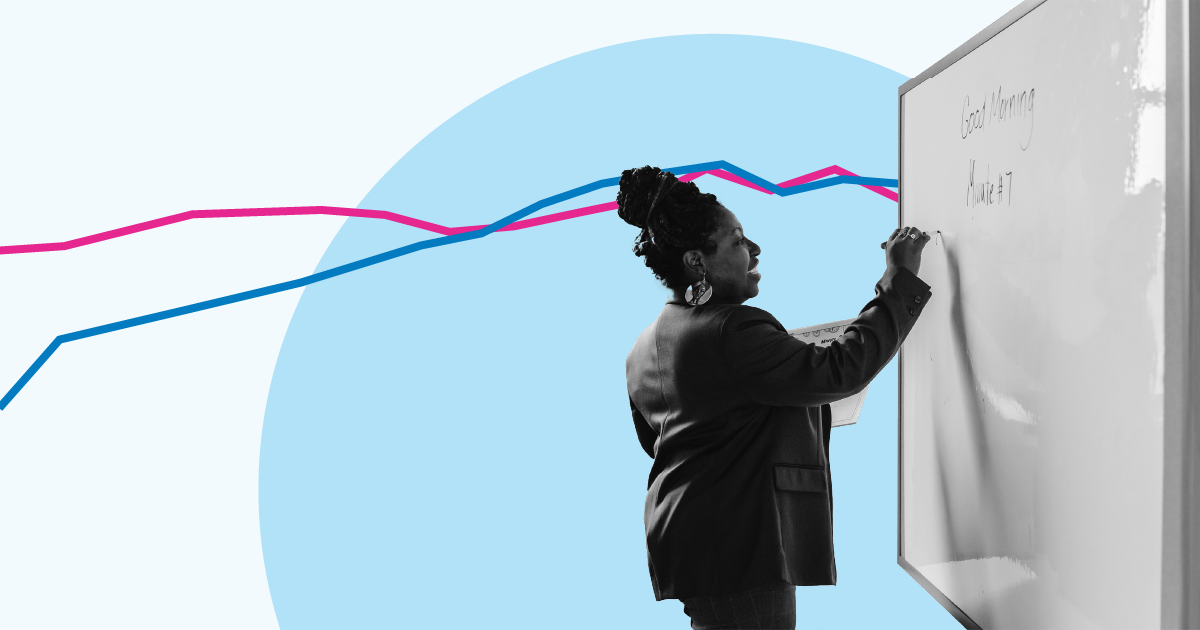Education
65% of households with children report the use of online learning during pandemic

As the school year continues amid a third wave of COVID-19 cases, the role of teachers has taken center stage. But who are teachers? The latest demographic information from the National Center for Education Statistics is from the 2017-2018 school year — which offers insight into educator demographics prior to the onset of the pandemic. That year, there were 3.5 million full and part-time public school teachers and around half a million private school teachers.
Women make up 76% of all teachers at public and private schools and an even larger share at the elementary school level. Women comprise 89% of teachers in public elementary schools, 72% of teachers in public middle schools, and 60% of teachers in public high schools.
Elementary school teachers, in addition to being the most likely to be women, also tend to earn less than teachers at higher grade levels. Public elementary school teachers have an average total school-year income of $58,700. Public middle school teachers average about $3,200 more per year, and public high school teachers average $5,600 more. That said, average earnings are lowest for people teaching at combined middle and high schools, though this may be related to other factors about communities where this format is more common.
Women are starting to make up more of the teaching staff at public middle and high schools. While the total share of public school teachers who are women now is only two percentage points higher than it was in the 1999-2000 school year, the share of public middle or high school teachers who are women grew by five percentage points.
A similar share of men and women hold master’s degrees among public school teachers — 49.6% of men and 49.1% of women. However, 9% of women hold even more advanced degrees, compared to 7% of men.
Non-Hispanic white Americans make up about 60% of the population but represent 79% of the teaching staff at public schools and 85% of teachers at private schools. Still, at least in public schools, the proportion of minority teachers increases substantially when most students share their racial and ethnic identity. For example, Black Americans comprise 7% of teachers in all public schools but 36% of teachers for majority-Black student bodies. Hispanic Americans make up 9% of all public school teachers but 33% of teachers for majority-Hispanic student bodies. Asian teachers make up 2% of all public school teachers but 27% of those in majority-Asian schools.
Even so, non-Hispanic white teachers still comprise 64% of staff across all schools where a majority of students are either Hispanic or non-white. Comparable information on private institutions is not available.
Black and Hispanic teachers also make up larger shares of the teaching staff at low-income public schools. At schools where three-quarters or more of the students are low-income enough to qualify for free or reduced-price lunch, Black teachers make up 14% of the staff and Hispanic teachers 17%. Meanwhile, schools where less than a third of children need subsidized lunch report that 2% of their teachers are Black and 5% are Hispanic.
Additionally, the shares of Black and Hispanic teachers are both five percentage points higher in city public schools compared to the overall public school system. Among private schools, Black and Hispanic teachers make up 3% and 7% of all teachers but 5% and 8% of teachers at schools located in the city.
Asian women and Black women are the most likely groups among public school teachers to hold a postgraduate degree — with 71% and 66% respectively reporting at least a master’s degree. Hispanic and Native American public school teachers, both men and women, are among the least likely to have a master’s degree or higher.
Around 57% of all teachers have a postgraduate degree — but it is most common in districts where few children are low-income enough to qualify for free or reduced-price lunches. Public schools where less than a third of children qualify for free or reduced-price lunch report that 63% of teachers have a master’s degree or higher. Public schools where half or more of the students are on free or reduced-price lunch report that 55% of teachers have the same qualifications.
Suburban public schools also report that a higher percentage of teachers — 61.7% — have postgraduate degrees. That may be connected to the relative wealth distribution between city, suburban, town, and rural areas. The average total income of a suburban public school teacher is $65,500 — around $3,600 more than city teachers and over $12,000 more than town or rural teachers. As teacher pay tends to be scaled by experience and degree status, this is an expected outcome in areas able to hire many highly educated teachers, even at greater expense.
Private schools also report a smaller share of teachers with postgraduate degrees than do public schools — 47.7% of all private school teachers. This again aligns with average salaries. Though certain private schools might pay well above the average, the normal income of a private school teacher across all schools is $47,700. That is $12,800 less than that of the average public school teacher.
Of public school teachers asked if they would leave teaching as soon as possible if they could get a higher-paying job, 65% disagreed to at least some extent, and over half of those teachers — or 35% of all teachers — strongly disagreed. Public school teachers in Massachusetts most often defended their career choice, with 78% indicating that they would not leave the field for a higher salary. Teachers in New Mexico were the most torn, with 52% saying they would pass up a chance at higher pay to continue teaching instead.
It’s worth pointing out that public school teachers are paid very differently from state to state, and Massachusetts public school teachers are paid more than public school teachers in New Mexico. More recent data on salaries from the 2018-2019 school year shows that teachers in New Mexico averaged an annual salary of $47,826 compared to $82,042 for Massachusetts teachers — a gap that does not close even if accounting for regional differences in cost of living. Using cost estimates from the Bureau of Economic Analysis, the purchasing power of the average public school teacher salary in New Mexico translates to $52,498, while it amounts to $74,788 in Massachusetts.
That said, 75% of Missouri public school teachers would also stay in teaching even if offered a higher-paying job elsewhere, and their cost-of-living-adjusted average salary is in the bottom twenty of all states.
Of course, the pandemic has since changed much about what it means to be a teacher, as educators reckon with both the health risks of in-person teaching and the challenges of online learning. Around 2% of all public school teachers are estimated to be over the age of 65, putting them in an at-risk age group for more severe and potentially fatal cases of COVID-19.
With cases growing ahead of the holidays, teachers and students are grappling with what class will look like for the second half of the school year.
Learn more from USAFacts and get the data directly in your inbox by signing up for our newsletter.
Education
Education
Education
Education
Newsletter
Keep up with the latest data and most popular content.


